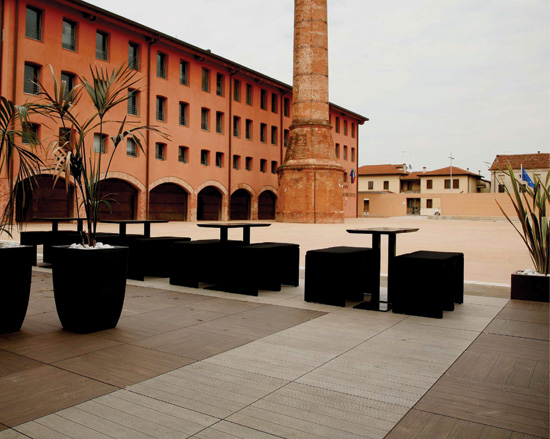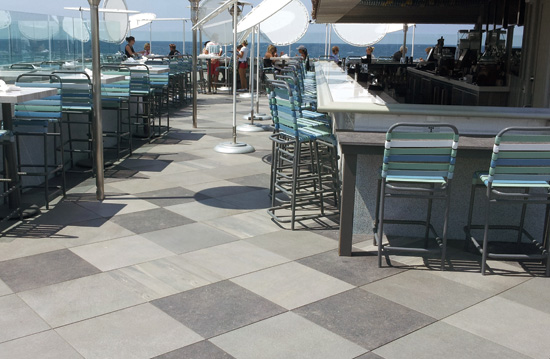A New Option in Exterior Paving
Dual-Layer Coupled Pavers. A two-piece construction comprising a top porcelain stoneware layer bonded to a ceramic base, these pavers are designed specifically for use with pedestal paver systems and raised floor applications where a higher distributed load rating is required. Note, however, that the concentrated load specification is normally higher with single slab pavers.
Interlocking Patio Tiles. High durability, 2 x 2 foot interlocking porcelain tiles with a porcelain surface layer bonded to a free draining plastic base, these tiles are designed for laying on grade directly over existing concrete in exterior applications including terraces, patios, pathways, swimming pool surrounds, trade-fairs, exhibition floors and outdoor areas of bars and restaurants. These tiles have the added advantage of easy removal for temporary exhibitions, displays, outdoor restaurants, and the like.
Wind Uplift Considerations
Will the pavers blow off in strong winds is a question that is frequently asked. Typically, when single slab porcelain pavers are installed on a pedestal system, they essentially rely on gravity, tight spacing between the pavers and tight containment around the perimeter to keep the pavers in place without movement. However the open joint space between pavers allows wind to flow above, below, and around the deck surface, which tends to reduce uplift forces somewhat and restricts movement of the pavers.
It should not, however, be inferred that uplifting of the pavers by wind will never occur as it is difficult, if not impossible, to test for every contingency or circumstance where wind uplift may be possible.
The Saffir-Simpson Hurricane Wind Scale defines wind speeds over 74 mph to be hurricane velocity where, for example, it is stated that a Category 1 (74-95mph) storm means: “Very dangerous winds will produce some damage: Well-constructed frame homes could have damage to roof, shingles, vinyl siding and gutters.” Furthermore, it is generally accepted that the average person standing on the open ground will be rocked around at wind speeds of 35-40mph; it is difficult to stand up and frequent stumbling would be expected.
While no official wind uplift test currently exists for an elevated paver system using a pedestal system, the Florida Building Code 2007 TAS No. 108-95 Test Procedure for Wind Tunnel Testing of Air Permeable, Rigid, Discontinuous Roof Systems may have some relevance to pavers installed in floating deck applications. Some manufacturers have gone beyond the limitations of this testing application standard, commissioning independent tests by the Florida International University International Hurricane Research Center to evaluate the resistance to wind uplift of porcelain pavers installed on a pedestal system using the FIU’s Wall of Wind facility. Variables incorporated in that test program included different wind angles, pedestal height and type, parapet wall height, paver layout and the use of locking devices along the parapet walls. The results of the study indicated that the wind speed observed at which blowoff of the ¾-inch-thick porcelain pavers placed over half-inch-high fixed height pedestals and with a 12-inch-high parapet around the test bed was 150 mph at a 30° wind angle.
Architects should note the complete results of this type of study may be available from a manufacturer upon request, and may provide additional and more practical data relating to wind uplift for specific single slab porcelain pavers installed on fixed or adjustable height pedestals; however, this does not constitute a guarantee or warranty of any kind, or as a substitute for the engineer’s, specifier’s, architect’s, builder’s or contractor’s own analysis, investigation, and due diligence regarding the appropriate choice, application and installation of porcelain pavers on fixed or adjustable height pedestals in any particular location or application.

Photo courtesy of Kronos Ceramiche
Porcelain pavers can contribute to LEED points in several areas.
Sustainability
By its very nature, porcelain is a sustainable material as it is made from plentiful, naturally occurring substances, clay and water. Porcelain pavers can be completely recycled into building materials such as cement, brick, or artistic tile mosaics. Porcelain pavers contain no sealants, waxes, or other chemicals that could release Volatile Organic Compounds (VOC) into the environment. The durability of porcelain paver alleviates the need for excessive polishing or sealing.
Further, porcelain pavers have the potential to contribute to the US Green Building’s Leadership in Energy and Environmental Design (LEED) rating system in several areas in the LEED-NC rating system for New Construction & Major Renovations, including Sustainable Sites, Water Efficiency, Energy & Atmosphere, Materials & Resources, Indoor Environmental Quality, Innovation & Design Process.
Sustainable Sites:
This category refers to reduction in environmental damage, pollution and other harmful effects due to building construction including the heat island effect created in urban environments by paved surfaces.
SS Credit 7.1 - Heat Island Effect: Non Roof (1 LEED point)
Most porcelain pavers do not contribute to a change in the energy balance of the environments where they are installed. They don’t produce any Urban Heat Island Effect, thanks to the high Solar Reflectance Index SRI ≥ 29.
Energy & Atmosphere:
This category refers to energy efficiency within buildings and prevention of ozone depletion.
Use of renewable on-site energy and the use of green power are credits available to building owners.
EA Credit 1 - Optimize Energy Performance (1-10 LEED points)
The thermal conductivity of porcelain tiles is typically around 0.75 Btu/ft. h °F (1.3 Watt/m°K or 1.1 Kcal/m h °C).
Materials & Resources:
Recycle, reclaim and reuse is the focus of this category.
MR Credit 4.2 - Recycled Content, 20% (post-consumer + ½ pre-consumer): (2 LEED points)
Porcelain pavers can be produced with as much as 40 percent of pre-consumer recycled materials.
MR Credit 5.2 - Regional Materials, 20% Extracted, Processed & Manufactured Regionally: (2 LEED points)
Indoor Environmental Quality:
The emphasis in this category is on providing a healthy indoor environment.
EQ Credit 4.2 - Low-Emitting Materials, Paints & Coatings: (1 LEED point)
Architects should look for tiles that are certified by independent laboratory tests to have no traces of VOC (Volatile Organic Compounds).
Innovation & Design Process:
This category provides recognition for innovative design strategies that may not be reflected within the credits otherwise provided by LEED
ID Credit 1.1 - 1.4 Innovation in Design: (1-4 LEED points)
This credit requires documentation to describe the proposed project design, how it exceeds current requirements, and demonstrate compliance and strategies to meet the requirements.
If interested in sustainably produced pavers, architects might consider pavers that have been produced in manufacturing plants with environmental management systems compliant to ISO 14001:2004 and other rigorous certifications and environmental standards that relate to safeguarding the environment and undertaking continuous improvement in environmental integrity for both products and manufacturing sites and ensuring the healthcare of the workforce. Such environmentally sound parameters might include manufacturers that have substantially reduced their CO2 emissions with new investment planned for further reduction as well as those that utilize heat generated during the production process and electricity derived from co-generation and hydroelectric power. Collecting and reusing 100 percent of the waste-water produced during the manufacturing process and using packaging materials produced from recycled paper are other hallmarks of manufacturers that are committed to environmentally sound operations.
Applications

Photo courtesy of Kronos Ceramiche
Porcelain pavers are used in a variety of public and commercial spaces.
Porcelain paver systems are ideal for use in a range of public and commercial spaces, and essentially for any application where there is a sloping or uneven surface and a perfectly level deck is desired. Rooftops are particularly popular applications for porcelain pavers.
Interlocking porcelain tiles which incorporate a porcelain tiled surface bonded to a plastic mesh base are one option that could be considered for a rooftop deck. These tiles eliminate the need to install any permanent structural supports or bearers, which is generally the major impediment to installing a roof deck. In condos and co-ops, the building owners typically will not permit the construction of any ‘permanent’ structures on a rooftop. These interlocking deck tiles can be simply snapped together right over the existing roof surface, creating an instant ‘floating’ rooftop patio.
In order to avoid damage to the waterproof membrane on the roof top, interlocking tiles typically provide a substantial number of “feet” on the underside of the integral plastic base. These feet distribute any load evenly over the surface below, so under normal circumstances with typical waterproofing materials, the feet should not dig into or damage the membrane. Installing a layer of EPDM sheeting over the existing roof surface before laying the tiles may add an extra measure of protection against damaging the roof surface.

Photo courtesy of HandyDeck
Pavers from different pallets should be mixed to create an appealing visual blend.
However, one of the main problems in building decks over rooftops is that the surface will typically slope in at least one direction to a drainage point. Consequently, if interlocking deck tiles are utilized, the tiles will follow the existing slope and thus the surface will not be perfectly horizontal. In many cases this does not represent a problem—the tiles can be simply laid directly over the rooftop surface as described above. However, if a perfectly horizontal surface is desired that does not involve the trouble and expense of constructing a sub floor with bearers, the obvious choice is an elevated pedestal system.









